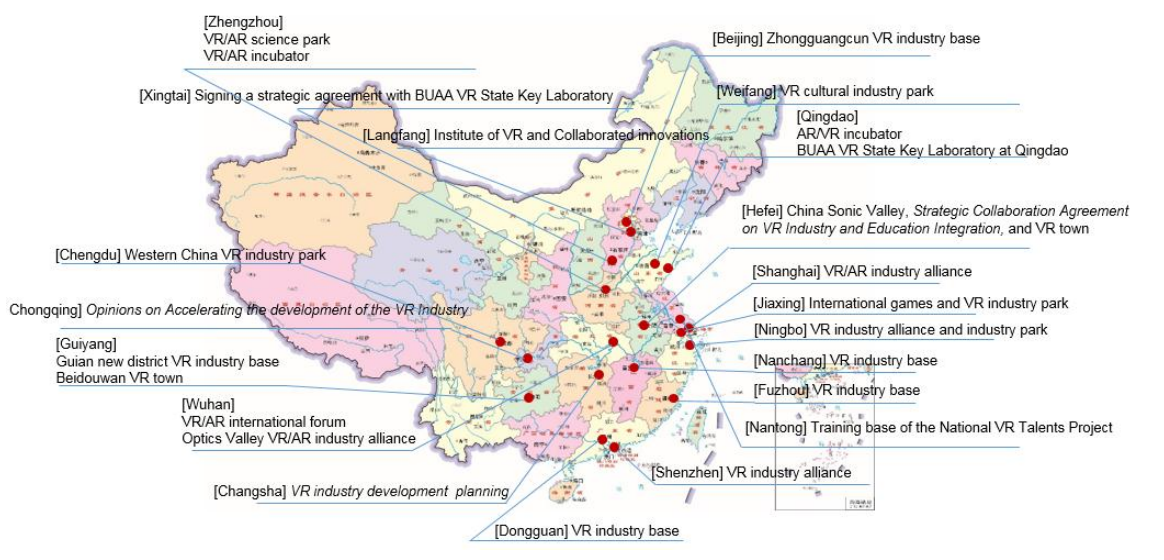- A key component to China’s fervent VR/AR push unquestionably has been the government’s unwavering commitment to ensure that “new technologies such as virtual reality” are a part of the country’s new round of scientific and industrial revolution.
- In addition to the government, VR/AR has also caught the attention of China’s tech giants, including Alibaba, Baidu, Tencent and mobile-provider Xiaomi. Each has launched its own initiatives to further develop the technology for various applications, including immersive video and gaming, mobile VR and online shopping and mobile VR.
With virtual reality (VR) and augmented reality (AR) continuing to boom in the wake of the coronavirus pandemic, China unquestionably finds itself in a very strong position to capitalise on this increased demand. This is possible thanks to its widespread commitment to accelerate the development and integration of this technology throughout its consumer and business sectors. Driven by China’s unrivalled 5G rollout and a fierce determination to “scale up” VR/AR as a critical digital economy industry to rapidly establish a “Digital China”, the country was estimated to account for almost 56% of global VR/AR spending in 2021. In doing so, it has cemented its position as a leading force in this industry.
Strong government support
A key component to China’s fervent VR/AR push unquestionably has been the government’s unwavering commitment to ensure that “new technologies such as virtual reality” are a part of the country’s new round of scientific and industrial revolution. This, in turn, not only instilled a general perception among the public, investors and companies that VR/AR was “cool” but also translated into a host of tangible actions. Some examples are the inclusion of VR/AR in numerous national strategy documents, including the 13th and 14th Five-Year Plans (FYP), Made in China 2025, and Internet+, to name a few, as well as a series of industry-related initiatives. These, for example, comprised the so-called “VR+” initiative, which aimed to promote the integration of these new technologies in established industries, and the construction of so-called “VR towns” in Donghu (Nanchang) and Guian New Area (Guizhou). Collectively, these actions provided a decisive impetus for establishing a very well-rounded infrastructure for innovation in this domain.
This widespread government support has not only been limited to the country-level, however, as illustrated by a recently released white paper on VR/AR by the China Academy of Information and Communications Technology (CAICT), Huawei and BOE. The white paper highlighted how the competition among cities and local governments is also driving innovation and development. In this context, Beijing, Shanghai, Guangzhou and Shenzhen find themselves in an advantageous position, thanks to their relatively mature and complete ICT industry chain, dominant IP holders, and active investing and financing. Other local cities and provincial governments are unwilling to miss this express train, thereby accelerating various new VR/AR clusters.

Figure 2 – VR industry development layout in some provinces and cities in China
Source: Virtual Reality / Augmented Reality White Paper (2017)
For example, Qingdao and Nanchang’s local governments are also driving VR/AR development forward. Regarding the former, Qingdao consistently contributes a wide variety of scalable and productive solutions to expedite the local VR/AR industry, thanks to the presence of high-quality research institutes, such as the Qingdao Research Institute of Beihang University and the recently-established Goertek R&D center. In addition, there is significant venture capital investment and enabling industry policies. On the other hand, Nanchang has also achieved remarkable growth in the past three years, culminating in its appointment as the permanent site of the annual World Conference on the VR Industry in 2018. Moreover, several prominent companies, including Huawei, Alibaba, Microsoft, HTC, Qualcomm and iFLYTEK, opened new offices in the VR industry base.
Considerable involvement of tech giants
In addition to the government, VR/AR has also caught the attention of China’s tech giants, including Alibaba, Baidu, Tencent and mobile-provider Xiaomi. Each has launched its own initiatives to further develop the technology for various applications, including immersive video and gaming, mobile VR and online shopping and mobile VR.
Hardware development, in particular, appears to be a sector in which these companies can excel, given their manufacturing prowess and presence of strong players, including Lenovo, HTC Vive, Yi Technology, Xiaomi, Deepoon VR, Goertek and Huawei, to name a few. Huawei, in particular, has the potential to further enhance the VR/AR experience thanks to its leading role in the development of 5G networks, which emphasise ultra-high-speed, low-latency, massive connections, ubiquitous networks, and low power consumption. In this context, Huawei, for example, released the “AR Insights and Application Practice White Paper” at the 5G+AR Global Summit, which predicted that the market space of AR will reach USD 300 billion by 2025, with priority being given to the following five significant industries: education, social networking, shopping, travel navigation and games.
However, to fully capitalise on the persistent advances in hardware development, it will be vital to couple these developments with content creation, as illustrated by a PwC report. The report estimated that VR content revenue alone would reach a staggering USD 3.6 billion in China in 2021 – predominately from the video and gaming sectors. Tencent, in particular, represents a dominant force in this context, thanks to its wide range of global acquisitions and investments, which, for example, has enabled it to acquire a 40% share of the Epic Games, which owns the most powerful real-time 3D creation platform – Unreal Engine.
Conclusion and Outlook
Thanks to the widespread support of the government, as well as the availability of significant funds and the involvement of some of the world’s leading tech companies, it appears likely that China will continue to lead the development of cutting-edge VR/AR technologies and applications. In this context, it is interesting to note that Chinese VR/AR has primarily focused on its domestic consumer base, thereby raising the question to what degree it will penetrate the global market in the future. Given the considerable scale of the Chinese market, this should by no means be interpreted as a limiting factor, however, as illustrated by a recently released Equal Ocean Intelligence report. The report estimated that China’s VR/AR terminal hardware market size would reach an impressive RMB 180 billion in 2021, with its VR/AR application service market size projected to exceed RMB 120 billion.
References
Center for Security and Emerging Technology (CSET). Translation of the Outline of the People’s Republic of China 14th Five-Year Plan for National Economic and Social
Development and Long-Range Objectives for 2035. 12.05.2021. Available at: https://cset.georgetown.edu/wp-content/uploads/t0284_14th_Five_Year_Plan_EN.pdf.
China Academy of Information and Communications Technology (CAICT) and Huawei Technologies. “Virtual Reality/Augmented Reality White Paper.” 2017. Available at: https://www-file.huawei.com/-/media/corporate/pdf/ilab/vr-ar-en.pdf.
China Academy of Information and Communications Technology (CAICT), Huawei and BOE. 虚拟(增强)现实白皮书 [online]. 03.2021. http://qccdata.qichacha.com/ReportData/PDF/e63fa9c40afd35e758ca702f2c0ed1df.pdf (accessed on 15.02.2022).
China Daily. Nreal develops mixed reality technology in Wuxi [online]. 23.03.2020. https://www.chinadaily.com.cn/regional/2020-03/23/content_37534622.htm (accessed on 15.02.2022).
Equal Ocean. 2021中国VR/AR产业研究报告 [online]. 08.06.2021. https://www.iyiou.com/research/20210608865 (accessed on 15.02.2022).
FAGERBERG, Jan and SRHOLEC, Martin. “Innovation Systems, Technology and Development: Unpacking the Relationships”. In: LUNDVALL, Bengt-Åke, Joseph, K.J., CHAMINADE, Cristina and VANG, Jan [eds]. Handbook of Innovation Systems and Developing Countries: Building Domestic Capabilities in a Global Setting. Cheltenham and Northamption (MA): Edward Elgar Publishing, 2009, pp. 83-118.
Goertek. Goertek Company Profile [online]. 2016. https://www.goertek.com/en/about/intro.html (accessed on 15.02.2022).
G20 Research Group, University of Toronto. 2016 Hangzhou Summit [online]. 02.12.2019. http://www.g20.utoronto.ca/2016/160903-xi.html (accessed on 15.02.2022).
Huawei Strategy Analytics. AR 洞察与应用实践白皮书 [online]. 2021. https://carrier.huawei.com/~/media/CNBGV2/download/bws2021/ar-insight-and-application-practice-white-paper-cn.pdf (accessed on 15.02.2022).
IDC. IDC发布2021年AR/VR 市场10大预测 [online]. 13.01.2021. https://www.idc.com/getdoc.jsp?containerId=prCHC47313321 (accessed on 15.02.2022).
IDC. VR产业研究白皮书. 2020. ‘Research on VR Industry’. Available at: https://www.shangyexinzhi.com/article/2554690.html.
LIAO, Rita. Qualcomm-powered Chinese XR startup Nreal raises $40 million [online]. 04.09.2020. https://techcrunch.com/2020/09/04/nreal-raises-40-million/?guccounter=1&guce_referrer=aHR0cHM6Ly93d3cuZ29vZ2xlLmNvbS5oay8&guce_referrer_sig=AQAAAJ0giPi_QT1TgfGZ7gsrNo8ZuX2OCSs04R-XIRgC85Yq4PtKkaAB5dA0MZui_8aO2UdJNnDToKvio_aYF-hIs0UH-Qrr3Uz5ph0hn4BhLU73yIqtTyu9GPpyv4Ak7KKmYBVXACCotzta_As9t9eRvRnbVEEtLL49D99L1XdpzXc1 (accessed on 15.02.2022).
MOKYR, Joel. “Technology”. In: The New Palgrave Dictionary of Economics. London: Palgrave Macmillan, 2008, pp. 1-9.
SOO, Zen. Chinese will use 86 million virtual reality headsets within five years [online]. 08.06.2021. https://www.scmp.com/tech/social-gadgets/article/2097509/chinese-will-be-using-86m-virtual-reality-headsets-within-5 (accessed on 15.02.2022).
STEIBER, Annika. VR/AR in China: An Emerging Giant? [online]. 19.12.2017. https://www.forbes.com/sites/charliefink/2017/12/19/vrar-in-china-an-emerging-giant/?sh=234420a75738 (accessed on 15.02.2022).
SUTHERLAND, Ivan. The Ultimate Display: Information Processing Techniques. 18.04.2003. Available at: http://papers.cumincad.org/data/works/att/c58e.content.pdf.
The Ministry of Industry and Information Technology. VR产业白皮书. 20.04.2016. Available at: https://www.cnblogs.com/iamliuxin/p/5617785.html.
The State Council. 国家中长期科学和技术发展规划纲要(2006—2020年). 2006. Available at: http://www.gov.cn/gongbao/content/2006/content_240244.htm.
VR Tuoluo. 2020年全球VR/AR行业融资报告. 14.01.2021. Available at: https://www.vrtuoluo.cn/522463.html.






NO COMMENT